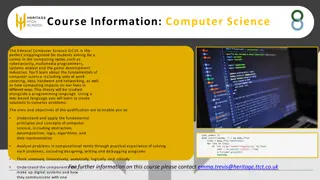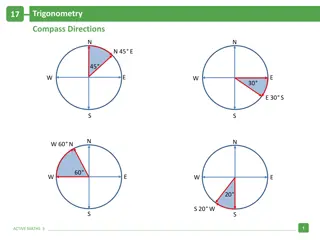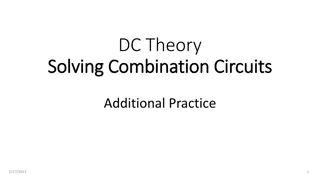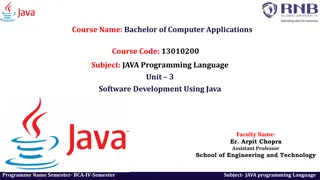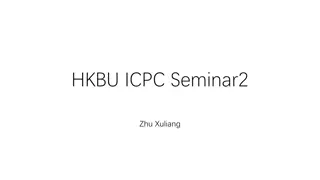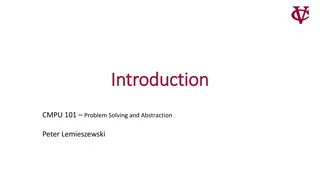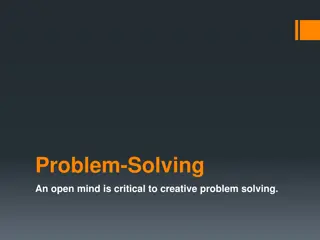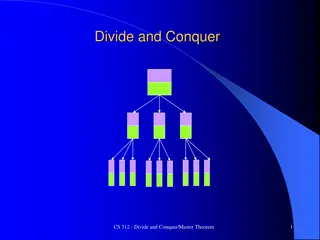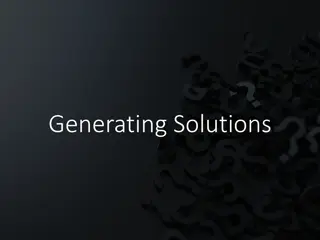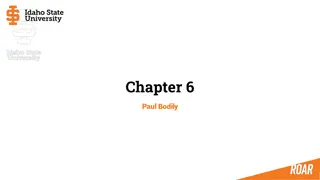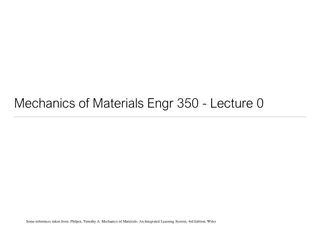Computer Fundamental & Problem-Solving Techniques in BCA
This comprehensive guide covers topics such as Number Systems, Decimal Number Systems, Binary, Octal, Hexadecimal Conversions, and more. It explores the Decimal Number System's intricacies, its ten distinct numerals, positional representation, weights associated with digits, and powers of 10. Detailed examples illustrate concepts to facilitate understanding.
Download Presentation

Please find below an Image/Link to download the presentation.
The content on the website is provided AS IS for your information and personal use only. It may not be sold, licensed, or shared on other websites without obtaining consent from the author.If you encounter any issues during the download, it is possible that the publisher has removed the file from their server.
You are allowed to download the files provided on this website for personal or commercial use, subject to the condition that they are used lawfully. All files are the property of their respective owners.
The content on the website is provided AS IS for your information and personal use only. It may not be sold, licensed, or shared on other websites without obtaining consent from the author.
E N D
Presentation Transcript
COMPUTER FUNDAMENTAL & PROBLEM SOLVING TECHNIQUES BCA 1001 By Himanshu Shukla Assistant Professor Department Of Computer Application UIET, CSJM University, Kanpur
Classification of Number System Decimal Number Systems Binary number Systems Octal Hexadecimal Number conversion
Decimal Number System Numbers are almost universally written in a form of notation known as positional number representation. A number is represented as a string of digits.
Decimal Number System In a decimal number there are ten such digits that may be used, ranging in value from zero to nine Decimal numbers are positional numbers that have a base or radix of ten. Why ten ?
Decimal Number Systems Exactly ten distinct numerals in order to represent all possible values for each position in the number, and hence to enable us to represent all possible integer numbers in decimal notation. 0, 1, 2, 3, 4, 5, 6, 7, 8, and 9 values For example, a number like "0123456789" has ten positions and each position can contain the digits 0-9.
Decimal Number Systems Each digit position has a weight associated with it. Each digit corresponds to a power of 10 based on its position in the number Number s value = a weighted sum of the digits
Decimal Number Systems The BASE is 10 or Dec or simply D BASE = 10 10 3 102=100 103=1000 Power or Exponent Base 10 101=10 100=1
Decimal Number System Example 159310 = 1x 103 + 5x 102 + 9x101 +3x100 = 1000 + 500 + 90 + 3 = 159310
Decimal Number System Example 357610 = 3x 103 + 5x 102 + 7x101 +6x100 = 3000 + 500 + 70 + 6 = 357610
Decimal Number System Summary In the decimal system, there are 10 digits (0 through 9) which combine to form numbers as follows: 0 1 2 3 4 5 6 7 8 9 10 11 12 13 14 15 16 17 18 19 20 21 22 ...
Binary Number System The term computer numbering formats refers to the schemes implemented in digital computer and calculator hardware and software to represent numbers Digital Computers and Calculator use a binary systems
Binary Number System Easy to represent binary values electrically Voltages and currents. Can be implemented using circuits Create the building blocks of modern computers
Binary Number System Reliability With only 2 values, can be widely separated, therefore clearly differentiated Binary numbers are made of binary digits
Binary Number Systems Base is 2 Two symbols: 0 and 1 Each place is weighted by the power of 2
Binary Number Systems All the information in the digital computer is represented as bit patterns What is a bit pattern? This is one bit 01010101 This is called as the bit pattern
Binary Number Systems Look at this bit pattern 0101 0101 How many bits are present ? Count the number of ones and the zeros in the above pattern Answer = Total 8 bits
Binary Number System 0101 0101 This pattern is represented as follows in the digital computer Bit7 Bit 6 Bit 5 Bit 4 Bit 3 Bit 2 Bit 1 Bit 0 0 1 0 1 0 1 0 1
Binary Number Systems A single bit can represent two states:0 1 Therefore, if you take two bits, you can use them to represent four unique states: 00, 01, 10, & 11 And, if you have three bits, then you can use them to represent eight unique states: 000, 001, 010, 011, 100, 101, 110, & 111
Binary Number Systems With every bit you add, you double the number of states you can represent. Therefore, the expression for the number of states with n bits is 2n. Most computers operate on information in groups of 8 bits,
Binary Number Systems Bit7 Bit 6 Bit 5 Bit 4 Bit 3 Bit 2 Bit 1 Bit 0 0 There are 8 bits in the above table 1 0 1 0 1 0 1 Group of 4 bits = 1 Nibble Group of 8 bits = 1 Byte Group of 16 bits = 1 Word 2 Bytes = 1 Word
Binary Number Systems Bit7 Bit 6 Bit 5 Bit 4 Bit 3 Bit 2 Bit 1 Bit 0 0 There are 8 bits in the above table 1 0 1 0 1 0 1 Bit 0 is called the Least Significant Bit LSB Bit 1 is called the Most Significant Bit MSB
Binary Number Systems Bit positions and their values Bit7 Bit 6 Bit 5 Bit 4 Bit 3 Bit 2 Bit 1 Bit 0 27 26 25 24 23 22 21 20 128 64 32 16 8 4 2 1
Decimal to Binary For Each Digit Position 1.Divide decimal number by the base (e.g. 2) 2. The remainder is the lowest-order digit 3. Repeat first two steps until no divisor remains.
Convert Decimal to Binary Example: Convert Decimal 13 (13 10) to Binary : Repeated division by 2 (till quotient is zero) Divide-by -2 Quotient Remainder 15/2 7 / 2 3 / 2 1 / 2 7 3 1 0 1 1 1 1 Answer = 11112
Convert Binary to Decimal Example: Convert 11012 Multiply each 1 bit by the appropriate power of 2 and add them together. 1 0 1 1 Bit 3 Bit 0 Bit 1 Bit 2
Convert Binary to Decimal Example: Convert 11012 Bit7 Bit 6 Bit 5 Bit 4 Bit 3 Bit 2 Bit 1 Bit 0 27 26 25 24 23 22 21 20 128 64 32 16 8 4 2 1 1 1 0 1 Multiply with these values 8 x 1 + 4 x 1 + 2 x 0 + 1x 1 = 8 + 4 + 0 + 1 = 13
Binary Number System Example: 11112or 1111B = 1 x 23 + 1x 22 + 1 x 21 + 1 x 20 = 8 + 4 + 2 +1 = 1510
Binary Number System Example: 101102or 10110B 1 x 24+0 x 23 + 1 x 22 + 1 x 21 + 0 x 20 = 16 + 0 + 4 +2+0 = 2210
Octal and Hexadecimal Number System Octal and hexadecimal are a convenient way to represent binary numbers, as used by computers. Computer mechanics often need to write out binary quantities, but in practice writing out a binary number such as
Octal and Hexadecimal Number System 1001001101010001 is tedious, and prone to errors. Therefore, binary quantities are written in a base-8 ("octal") or, much more commonly, a base-16 ("hexadecimal" or "hex") number format.
Octal Number Systems Base = 8 8 symbols: { 0, 1, 2, 3, 4, 5, 6, 7} Example 123, 567, 7654 etc How to represent a Decimal Number using a Octal Number System ?
Octal Number System Repeated Division by 8 Example 21310 = ( )8 ? Divide-by -8 Quotient Remainder Octal digit 213 / 8 26 / 8 3 / 8 Answer = 3258 26 3 0 5 2 3 Lower digit = 5 Second digit =2 Third digit =3
Octal Number System How to convert 3258 back to Decimal ? Use this table and multiply the digits with the position values Digit 8 87 Digit 7 86 Digit 6 85 Digit 5 84 Digit 4 83 Digit 3 82 Digit 2 81 Digit 1 80 32768 4096 512 64 8 1
Octal Number System How to convert 3258 back to Decimal ? Consider the above number 3 2 5 (8) Digit 1 Digit 3 Digit 2 3 x 82 + 2 x 81 + 5 x 80 = 3 x 64 + 2 x 8 + 5 x 1 = 192 +16 + 5 = 213
Octal Number System Example Convert 6118 Consider the above number 6 1 1 (8) Digit 1 Digit 3 Digit 2 6 x 82 + 1 x 81 + 1 x 80 = 6 x 64 + 1 x 8 + 1 x 1 = 384 + 8 + 1 = 393
Octal Number System Convert 393 to octal Divide-by -8 Quotient Remainder Octal digit 393 / 8 49 / 8 6 / 8 49 6 0 1 1 6 Lower digit = 1 Second digit =1 Third digit =6 Answer = 6118
Hexadecimal Number System Base = 16 or H or Hex 16 symbols: { 0, 1, 2, 3, 4, 5, 6, 7,8,9 } { 10=A, 11=B, 12=C, 13=D, 14=E, 15= F}
Hexadecimal Number System {0,1,2,3,4,5,6,7,8,9,A,B,C,D,E,F} It uses 6 Letters ! Example AA12, 87DF, CCF etc How to represent a Decimal Number using a Hexadecimal Number System ?
Hexadecimal Repeated Division by 16 Example 21310 = ( )16 ? Divide-by -16 Quotient Remainder Hex digit 213 / 16 13 / 16 13 0 5 Lower digit = 5 Second digit =D 13 Answer = D516
CONVERSION How to convert D516 to Decimal ? Use this table and multiply the digits with the position values Digit 8 167 Digit 7 166 Digit 6 165 Digit 5 164 Digit 4 163 Digit 3 162 Digit 2 161 Digit 1 160 4096 256 16 1 ..
Hexadecimal Number System How to convert D516 to Decimal ? Consider the above number D 5 (16) Digit 1 Digit 2 D x 161 + 5 x 160 = 13 x 16 + 5 x 1 = 208 + 5 = 213 References: 1. https://www.dce.kar.nic.in 2. https://tutorialspoint.com


